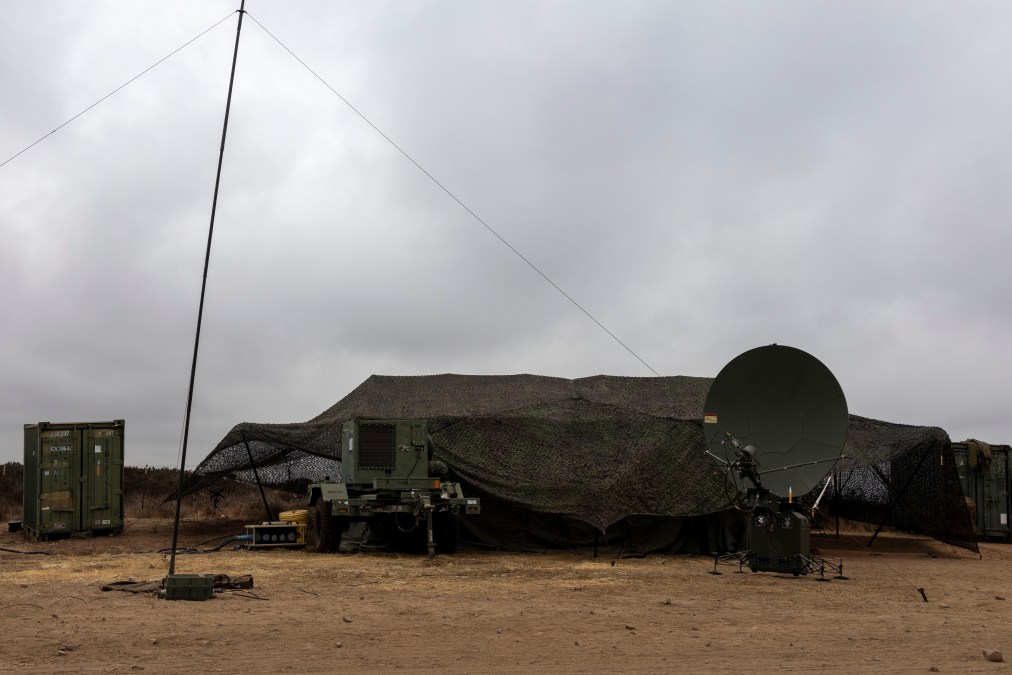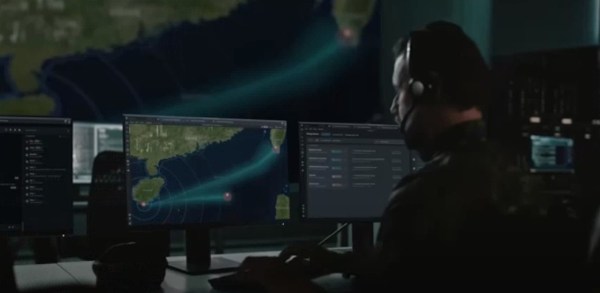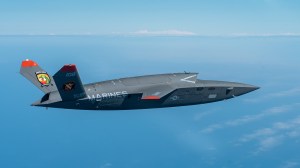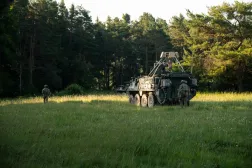Marines accomplish two communications ‘firsts’ at Army’s Project Convergence

For the first time, a Marine Corps communications squadron integrated non-military, commercial off-the-shelf sensors for maritime domain awareness into operations and plugged into the Army’s unclassified communications architecture to gain a joint common operational picture.
The pair of firsts was conducted as part of Project Convergence Capstone 5, the latest in an annual experimentation event hosted by the Army to test emerging concepts, largely in line with the Pentagon’s Combined Joint All-Domain Command and Control.
CJADC2, as it’s known, envisions how systems across the entire battlespace could be more effectively and holistically networked to provide the right data to commanders, faster. The word “combined” in the parlance of the framework refers to bringing foreign partners into the mix.
Marines placed commercial maritime radars, such as those that can be purchased at fishing or boating stores, at San Clemente Island off the coast of San Diego and integrated them into the Army’s Sensitive But Unclassified-Encrypted (SBU-E) architecture.
As the radar data was integrated into the unclassified network, Marines sent maritime tracks to the National Training Center at Fort Irwin, California, to ingest as part of its maritime domain awareness. Located nearby in Barstow, the Army then leveraged a cross-domain solution to bring those tracks up in classification to the secret network and then sent them back to the Marine Corps Tactical Systems Support Activity near San Diego to control a notional shooter simulating a Tomahawk strike on an adversary ship.
“We were able to validate that we can see the vessels out around San Clemente Island, pass that unclassified track data to Fort Irwin, get that up class to [SIPRNet] and then send it back to use it,” Maj. Anthony Johnson, an operations officer within Marine Air Control Group 38, said in an interview. “It demonstrated that if we were able to give these commercial sensors to a coalition partner or even if the military were to use these coalition sensors on this network, we can use that in tandem with our military sensors to contribute to maritime domain awareness for the component commander, being the joint maritime component commander.”
The demonstration gets to the heart of what the Pentagon desires to achieve with its CJADC2 initiative by not only integrating into a multiservice common operational picture, but also proving that commercial, non-U.S. military sensors can be integrated into operations. Oftentimes, coalition communications and equipment aren’t compatible with Department of Defense architectures (not to mention interservice compatibility issues), slowing down multination operations.
That coalition integration is one of the main draws for the Army’s SBU-E architecture. Officials have described that it has significantly sped up coalition operations because it negates the need for liaisons in formations communicating directions back and forth on multiple radio systems because the partners aren’t authorized to use classified communications or equipment.
The thought behind it is that tactical wartime information is so perishable — meaning it is acted upon and expires so quickly that even if the enemy were to discover plans, it would be too late — it does not need to be classified, increasing the speed of operations.
“It was demonstrating that we can have a common operational picture, a common tactical picture-like capability on the SBU network. It was cool to see how our commercial sensors can contribute to that common tactical picture that the Army’s Joint Modernization Command was monitoring over at Fort Irwin,” Johnson said.
The experimentation effort was also part of a small unit concept that the control group and communications squadron were testing out.
Johnson explained that the control group consisted of a detachment with a mix of Marines from Marine Air Support Squadron 3, 3rd Low Altitude Air Defense Battalion and Communications Squadron 38 forming a communication-sensor integration team. The concept, which doesn’t currently exist within the Corps, sought to pair communications Marines with air defenders and tactical data link maintainers to integrate commercial sensors and augment the Corps with ground-based maritime sensors in addition to what the unit already has.
Planning for the concept began in October after Project Convergence last year, where the unit realized that they always have to integrate radars into their network. But, taking it a step further, they wanted to prove they could integrate commercial sensors.
“In our minds for comm squadrons, well, we’re already doing military sensors, now we’re being presented an opportunity to do commercial sensors, so why don’t we start making a team that specializes in understanding how radars work and how to integrate them into military networks,” Johnson said. “For our occupational field, so for the communications MOSs, it validated that we can have small-scale teams that can perform this function of integrating commercial capability.”
More broadly, the concept, if fully realized, will enable the Corps to send small, task-organized teams out to multiple locations to contribute to maritime domain awareness, which could be critical in a Pacific theater fight given the various islands there, not to mention that smaller teams are more difficult to target.
“Right now, we have the TPS-80 radar and a couple other sensors that are not in the 3rd Marine Aircraft Wing, but those are few and far between, just due to the limited quantity of military equipment we have,” Johnson said. “Now that we’ve demonstrated this capability, now we can have more nodes, if you will, spread about multiple islands. So we can increase the sensor coverage in Indo-Pacom.”
Lessons from Project Convergence
While broadly a success, Johnson noted there were some coordination challenges during the event involving passing track data back and forth with the Army at Fort Irwin through the service’s cross-domain solution. However, once the requirements were understood between both organizations, it was a quick turnaround to instantly pass track data through SBU-E to the secret network.
Following Project Convergence, Johnson said his unit is looking to get the devices necessary to enable them to access the SBU-E environment, given that’s not a capability the Corps possesses currently. They’re hoping to integrate the architecture into squadron internal events such as an 18.6-mile foot march in early May, where Marines will ruck with 25 pounds.
They plan to integrate SBU-E with the Tactical Assault Kit to be able to see and track participants as they conduct the march.
The experimentation also showed that with commercial sensor integration, the Corps could potentially look to COTS capabilities to supplant more exquisite, military-built systems that can be more costly and time-consuming to acquire.
“Why we use it in a Marine Corps blend scenario, like we talked about how coalition partners can also have these as well, but this also gives the Marine Corps more capability with something that’s significantly cheaper than a programmatic solution that takes upwards to a decade to field, as well as to refurbish and update,” Johnson said. “Perishable commercial equipment, if it’s attritted or if it’s broken for whatever reason, it’s easily replaceable [rather] than having to wait with long lead times.”
Given the success of the communication-sensor integration team concept, Johnson said his organization will be entering a working group with the other communications squadrons across the Corps in early May to add the concept as an advanced mission essential task they are all required to perform.
“The task would be to integrate organic and non-organic sensors into Marine Corps networks. Since we realize that this is a continuous task that our Marines are having to perform, we want to register that as a requirement, where we’re actually appropriately evaluated on the ability to be able to do this,” he said. “That way, we can signal to headquarters Marine Corps that when the exercise presents itself, that we’ve actually done that task, instead of it just being for the sake of experimentation.”






